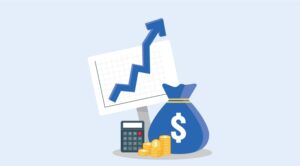When it comes to money, almost every family has some complications when it comes to managing household cash flow. But when one or both of the earners in the same home have an irregular cash flow new issues of cash management can arise. So, having a method for paying yourself is an essential component of managing your company and your home.
Peter and I work with many Real Estate agents and small business owners who both need to manage the erratic income in their businesses and the effects that they have on their homes. This is a spectacular space for a CFP® to assist these solopreneurs with how to measure, modulate, and manage their cash flow.
Here are the first steps for small business owners and solopreneurs can use to get a handle on their cash flow and prepare themselves for change:
Step 1: Figure out your monthly expenses
The first step in knowing which direction to head is knowing where you need to be. A common misstep for solopreneurs is living off of what “comes in” each month. This leaves them reeling when business slows, taxes are due, or there is an unanticipated expense. This is an easy trap to fall into, especially when you are starting out and your income might feel lean. It’s an easy, yet often overlooked, essential step, to determine how much you need to cover each month.

This means, summing up mortgages, insurance, electricity, gas, groceries, and other essentials that make your home function. This is the number to build our plan from. Let’s call this number “Core 1”
Step 2: Determine the regular monthly salary you need
The number from above is a good starting point, but we need to get to a comfortable baseline so that we can begin crafting the automation and calculation from that point. A successful business should be able to support your costs at home and pay the taxes on that income.
Your salary should be: “Core 1” x 12 months + Expected Taxes (%) = This is “Your Salary”
If the income from your business is less than “your salary” you will need to secure other sources of income (investments, savings, other employment)
Work with a CFP® or CPA® to determine your expected taxes, but you will most likely be between 20% and 30% when it’s all settled (State Income + Federal Income + Payroll taxes). Having an InSight-Full® financial plan is helpful because we will know what the current and future expected tax rates will look like.
Step 3: Set up your “owners pay account”
The owner’s pay account is going to be the reservoir of cash that you will depend on going forward. All of the expenses you incur in the “Core 1” plus taxes are usually very regular. Each month these bills get paid, so the idea in the “owners pay account” is to keep those costs maintained and cash flow regularly meeting those needs.
This means if month one income is $12,000 and “Your Salary” is $8,000 then $4,000 will stay in the account for now. This also means that if your income for month two is $7,000 and “Your Salary” is still $8,000 you will be able to pay yourself regularly.
 Paying yourself constantly, and programmatically is key to forging stability in your home. It will pay dividends in the event you need to apply for credit (mortgage, auto loan, etc). A stable, predictable income is the best reason to work for someone else – and through this step, we have replaced that comfort for those people forging their own path.
Paying yourself constantly, and programmatically is key to forging stability in your home. It will pay dividends in the event you need to apply for credit (mortgage, auto loan, etc). A stable, predictable income is the best reason to work for someone else – and through this step, we have replaced that comfort for those people forging their own path.
This is a major milestone – celebrate this moment. In three steps, you will have saved yourself years of heartache, concern, and confusion.
I know some readers are sitting there asking themselves “what if these owners’ accounts end up too large”. It is perfectly okay to expel excesses deliberately on some established cadence. Think of “quarterly bonuses” and work with your CFP® to make sure your other accounts like an emergency fund, retirement plan, college fund, or brokerage account are funded where you want them. If everything is healthy, save more or spend it! Have fun and reward yourself for your hard work. The idea here is to avoid the risks that come with cash flow management – not hold all your funds in perpetuity.
Caution: The “Owners Pay Account” is NOT an emergency fund. This is an important distinction. While they can both be made available in the event of a dire need, they shouldn’t be viewed with the same intention. The “owners pay account” is expressly for creating regular and maintainable cash flow.
Step 4: Fund your emergency fund (EF)
Let’s face it, running your own business or being a solopreneur is living on the ragged edge of risk. The joys are tremendous – but so is the risk. To mitigate that risk you should take seriously the practice of an emergency fund (EF). The goal of the “owners pay” account is to streamline your payroll, the purpose of an emergency fund is to limit the contagion of other financial setbacks.
Ideally, you already have an EF in place and it is fully funded. But if you do not, work with your CFP® to determine the number you should hold. This number is typically 3-6 months of your expenses, and because your employment is tied to the success of the business and the success of the business is tied to the broader economy, you as a solopreneur likely need a larger and more well-defined EF strategy. So here are some characteristics that will make your Emergency Fund different from people who are traditionally employed:
- Your Emergency fund will likely be larger than others, think 6-12 months of expenses, depending on how employable your skills are should the business fail. As the business becomes more lucrative and established you can back this number down.
- Your fund should be a well-defined number. Many people will have a pool of cash that floats in a comfortable range – that might be fine for them to have that loose understanding of their financial buffer, but in your situation, it should have more of an exact figure and you should stick to that hardline.
- You should not commingle the EF with other accounts, it’s best to have a single account dedicated to this risk management effort and leave it alone. You will be less likely to let this cash drift into other expenses.
COACHES TIP – Do not get hung up on the interest rate, there is little you can do about it, it will change with the macroeconomics and it really isn’t the point of that account. Do what you can, use a good money market account, and just let it be. This account is about “risk management” not income, and most risk management (insurance, lawyers, compliance people, etc.) will cost you money, but this piece of risk management will make you some money. That should be good enough.
Step 5: Start investing outside of your Business
Many entrepreneurs are tempted to continue to pour revenue into their businesses. We get it, investment begets growth, but in our experience, too much investment can be made into the business, the returns are less than most business owners think, and it lacks diversity. No amount of reinvestment will make your company “fail-proof”, so it’s important to channel assets in a tax-advantaged way into your personal holdings.
The good news is there are several options for you to choose from. Traditional Retirement Plans are a good start, SEPs, 401(k)s and IRAs all have their own unique benefits and limitations. A Roth might be helpful, a Mega-Backdoor Roth for some is an option and there are even insurance strategies where your personal InSight-Full® financial plan stands to benefit from how you are managing your cash flow from the business.
Ideally, you will be able to expand on your “Core 1” number by adding 15-25% in savings so let’s call this number “Core 2”. “Core 2” then represents all of your taxable take-home income AND the pre-tax savings that you channel to an investment account.
So now the math is: Core 1 + Estimated Taxes + Core 2 = Your Salary.
We think having investments outside your business is essential. It allows you to use more predictable sources of wealth generation, like stocks, bonds, or real estate to accompany the future sale of your business. Some of these investments, chiefly real estate, will allow you to capture losses today (lowering your income taxes) while deferring gains well into retirement when your taxes will be lower.

COACHES TIP – If you have a business type that you don’t think you can sell (as in your business cannot exist without you), and there is no value to someone else to buy your book of business and assets, investing outside of your business is even more critical. This is because only these efforts and social security will be your primary sources of income in retirement.
Automation is key to making this step work well. Paying yourself regularly and investing regularly is not only a better habit for cash flow management, it actually produces investment results by dollar cost averaging your investments. Far too many solopreneurs and entrepreneurs find themselves waiting for a certain amount to get started in their retirement investing. Unfortunately, with this method, you’re missing out on essential capital appreciation and dividends while you wait for the right moment. Those who embrace automation find they are building the wealth snowball early and gaining momentum before they know it. Periodic savings with small amounts is also much easier than lump sum savings. Build habits and create an identity around the fact that you are a saver.
Step 6: Celebrate and Scale
We are now in pretty rarified air now. Mastery over your cash flow is a great feeling. If you are sitting there with a healthy balance in the “owners pay account”, a fully funded emergency fund, and you have an IRA/SEP/401(k) that is being invested in with each paycheck then it’s time to reflect and acknowledge what that means.
It means to have left behind is dependent on an employer, it means that there is a timeline to retirement, and it means that the expenses of running your home are taken care of. This is remarkable and you have avoided one of the major pains the other solopreneurs and entrepreneurs may struggle with regardless of their income.
If there are regular excesses, in the owner’s pay account use that to enjoy your accomplishments and celebrate with a vacation or gift to yourself. If you want to take this opportunity to sprint closer to retirement, work with your CFP® and make an additional investment into your future. This is what success feels like as your cash flow ecosystem is established and you get to regularly have the conversation about what to do with your extra cash, instead of which credit card do I put this payment on?



